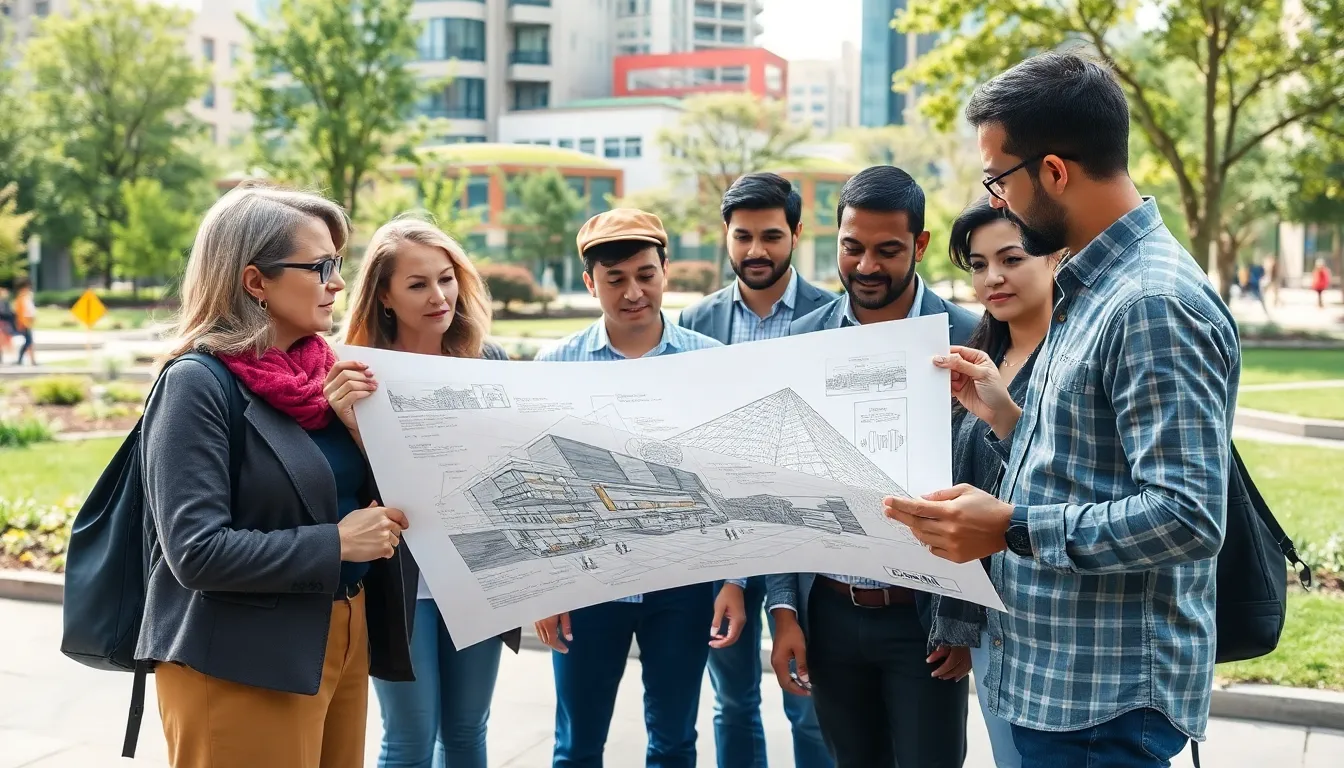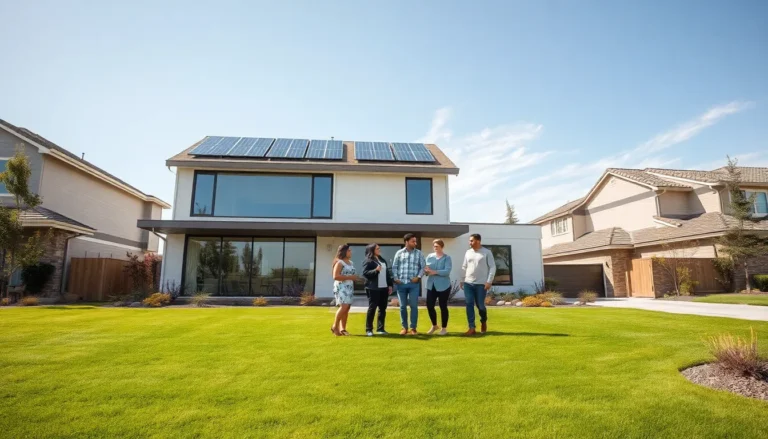Table of Contents
ToggleAs the planet warms and weather patterns turn into unpredictable roller coasters, architects and designers are stepping up their game with climate-adaptive design. This innovative approach isn’t just about slapping on solar panels and calling it a day; it’s about creating spaces that dance gracefully with Mother Nature. Imagine buildings that can withstand fierce storms while keeping their cool—literally!
Overview of Climate-Adaptive Design
Climate-adaptive design integrates strategies that allow structures to respond dynamically to climate variability. This approach considers local climate data, ensuring that buildings support resilience against natural elements. Structures designed with climate adaptations often incorporate materials that withstand harsh conditions such as flooding, hurricanes, or extreme heat.
Innovative techniques enhance energy efficiency while prioritizing sustainability. Green roofs, for example, serve to cool buildings and manage stormwater effectively. Incorporating natural ventilation reduces reliance on mechanical systems, thereby lowering energy consumption.
Climate-adaptive design also emphasizes flexibility in use. Spaces can be easily modified for various activities, accommodating changing needs over time. Moreover, when communities face specific climate threats, designs can incorporate local knowledge and practices for enhanced relevance and effectiveness.
Urban planning plays a vital role in climate-adaptive design. Collaborating with ecologists and engineers allows for the creation of interconnected systems that optimize land use. Well-planned developments can reduce urban heat island effects and manage water resources efficiently.
Fortifying infrastructure against climate impacts remains crucial. Strategic placement of structures within flood plains, for instance, helps minimize damage risks. Utilizing landscape features such as trees and wetlands enhances natural barriers, providing additional protection.
This adaptive design approach not only ensures immediate benefits but also supports long-term sustainable development. Architects and designers prioritize these strategies to create resilient environments capable of thriving amid climate uncertainties.
Principles of Climate-Adaptive Design
Climate-adaptive design centers on principles that enhance a building’s ability to respond to changing climate conditions. These principles ensure structures remain functional and sustainable in the face of environmental challenges.
Flexibility and Resilience
Flexibility allows spaces to adapt to various uses and climate impacts over time. Buildings designed for resilience withstand extreme weather events without compromising safety. For example, using movable walls enables interior layouts to change based on occupancy needs or seasonal variations. Designs that incorporate resilient materials—like reinforced concrete or impact-resistant glass—can better endure hurricanes and extreme storms. Structures featuring adjustable shading systems enhance comfort while maintaining energy efficiency. Architects prioritize resilience to protect investments, safeguarding the functionality and longevity of buildings.
Sustainability Considerations
Sustainability underpins climate-adaptive design principles through resource-efficient practices. Renewable energy sources, such as solar panels, contribute to overall energy independence. Rainwater harvesting systems reduce reliance on municipal water supplies while promoting conservation. The choice of environmentally friendly materials minimizes ecological footprints and fosters healthier indoor environments. Green roofs and urban gardens improve air quality, support biodiversity, and mitigate heat islands. Ultimately, sustainable strategies align with long-term ecological health, ensuring that designs contribute meaningfully to both the environment and the community.
Strategies for Implementing Climate-Adaptive Design
Effective strategies for implementing climate-adaptive design focus on enhancing resilience and sustainability in architecture. These strategies include site analysis and the use of sustainable materials.
Site Analysis and Contextual Design
Site analysis serves as a foundation for climate-adaptive design. Evaluating local climate data helps architects understand environmental conditions. Designers assess factors like wind patterns, rainfall, and temperature variations. Knowledge of the surroundings influences building placement and orientation. Strategic design choices promote natural ventilation and passive heating or cooling. Integration with the landscape minimizes environmental impact. Additionally, considering local flora and fauna maintains biodiversity. Prioritizing these elements supports adaptive strategies tailored to specific locations.
Use of Sustainable Materials
Sustainable materials play a critical role in climate-adaptive design. Materials such as bamboo and recycled steel offer durability and environmental benefits. Designers choose substances with low embodied energy to reduce carbon footprints. Incorporating insulation materials that outperform traditional options enhances energy efficiency. Utilizing regional materials lowers transportation emissions and supports local economies. In this context, selecting materials resistant to extreme weather conditions enhances longevity. The emphasis on renewable resources promotes overall ecological sustainability. Ultimately, sustainable materials contribute to buildings that thrive in changing climates.
Case Studies in Climate-Adaptive Design
Numerous projects demonstrate the effectiveness of climate-adaptive design. These examples highlight innovative solutions tailored to address local climate challenges.
Successful Projects
The Bosco Verticale in Milan showcases vertical forests integrated into residential towers. This initiative improves air quality while providing natural habitats. In New York City, the East Side Coastal Resiliency Project employs flood protection measures alongside parks. This transforms the waterfront into a community asset that mitigates flooding. The Cactus Towers in Denmark feature adaptable facades that react to temperature changes, enhancing energy efficiency. Each of these projects embodies principles of climate-adaptive design and contributes to urban resilience.
Lessons Learned
Successful implementations reveal several key lessons. Responsive design significantly improves both functionality and sustainability. Early engagement with community stakeholders fosters support and ensures designs meet local needs. Continuous monitoring of climate data allows for ongoing adaptations to structures and landscapes. Collaboration among architects, engineers, and ecologists is essential, promoting innovative strategies that address complex climate challenges. Each of these lessons underscores the value of an integrated approach in climate-adaptive design.
Future Trends in Climate-Adaptive Design
Emerging technologies signal a shift toward more responsive climate-adaptive design. Advanced materials are continually being developed, enabling structures to self-regulate temperature and moisture levels. Innovations like phase-changing materials and smart textiles contribute to increased energy efficiency and thermal comfort.
Monitoring systems enhance the adaptability of buildings. These systems allow for real-time tracking of environmental conditions, enabling dynamic responses to shifting climates. Integrating artificial intelligence into design processes helps optimize energy use, reducing overall consumption.
Community-centric designs are gaining traction. By focusing on user experience and local context, architects create spaces that meet specific needs while respecting environmental constraints. Collaborative approaches involving community input ensure these designs are culturally and socially relevant.
Nature-based solutions are increasingly prioritized. Urban forests, biophilic design elements, and integrated stormwater management systems promote ecological resilience. These approaches contribute to improved air quality and enhanced biodiversity.
Sustainable water management techniques are becoming standard. Rainwater harvesting and graywater recycling systems minimize water usage while promoting self-sufficiency. Designers emphasize the importance of integrating these practices into landscape planning.
Policy frameworks are shifting to support climate-adaptive design. Governments are beginning to incentivize sustainable building practices through grants and tax credits. Such measures encourage architects and developers to incorporate adaptive strategies in their projects.
Ultimately, the future of climate-adaptive design lies in innovation, collaboration, and sustainability. This approach fosters resilience against climate challenges while enhancing the quality of life for occupants. Engaging with local communities and leveraging new technologies sharpen its effectiveness.
Conclusion
Climate-adaptive design represents a vital shift in architectural practices aimed at addressing the challenges posed by climate change. By prioritizing resilience and sustainability, this approach not only enhances the safety of structures but also improves the quality of life for their occupants.
As cities evolve in response to environmental pressures, innovative solutions will continue to emerge, fostering a more integrated relationship between the built environment and nature. By embracing collaboration and community engagement, architects and planners can create spaces that are not only functional but also adaptive to future climate scenarios.
The ongoing advancement of technologies and sustainable practices will play a crucial role in shaping resilient urban landscapes, ensuring they withstand the test of time and climate variability.








